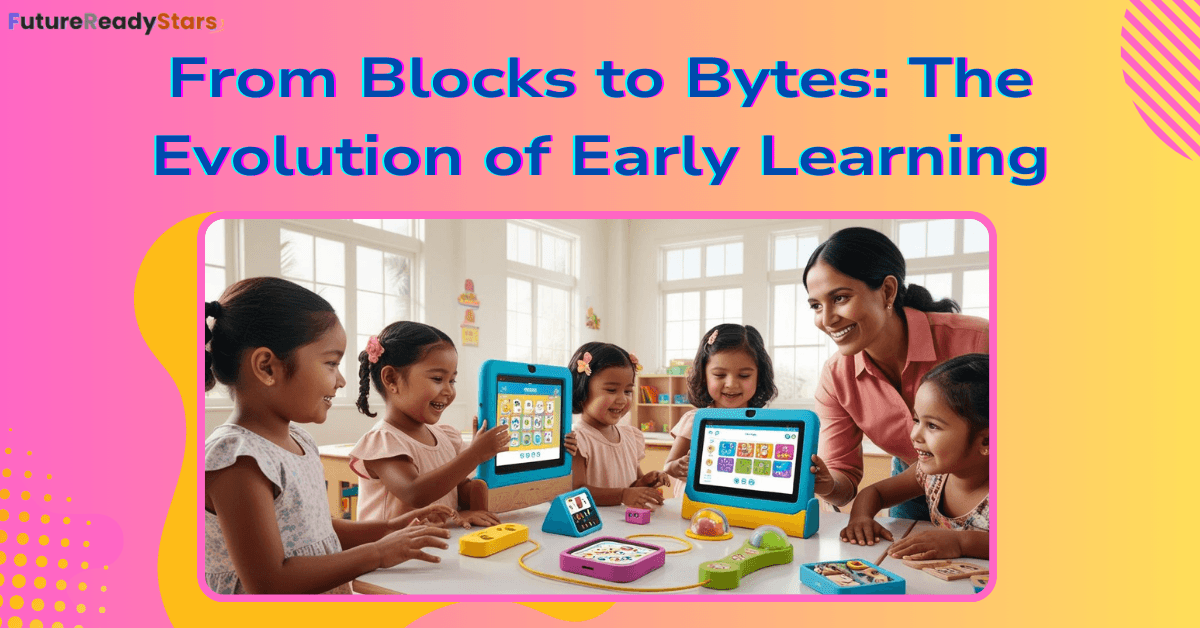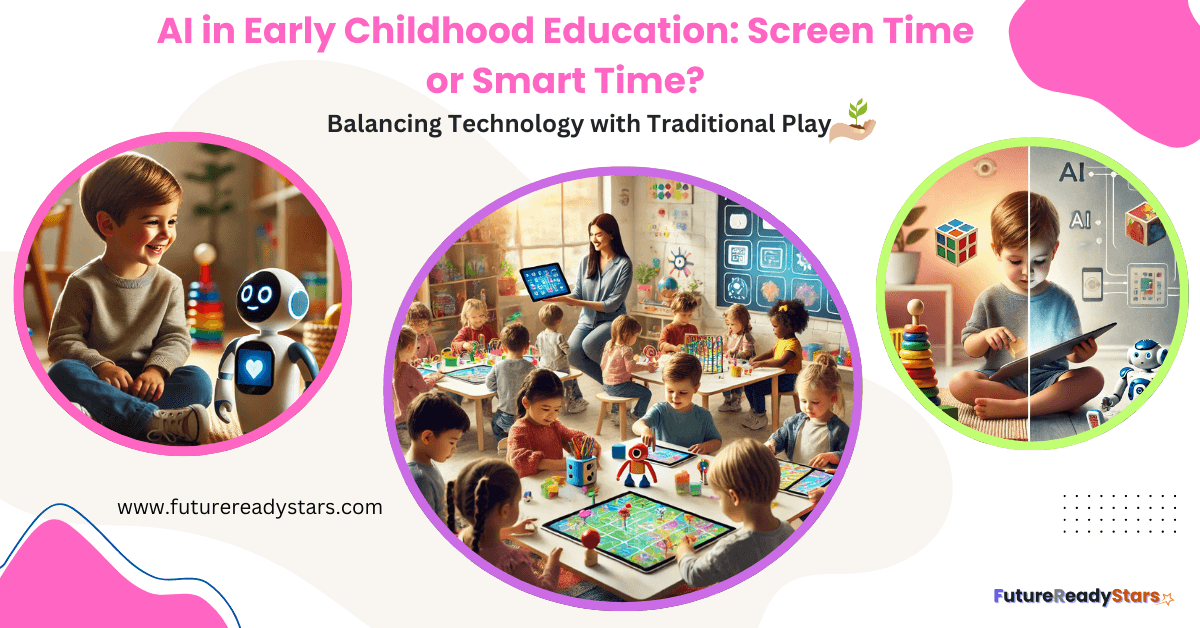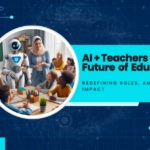How Parents and Teachers Are Using AI to Turn Play into Learning

Introduction
AI in Early Childhood Education is no longer a futuristic concept—it’s happening now. In fact, from interactive learning apps to AI-powered storytelling tools, technology is reshaping how young children engage with education. However, does this innovation truly enhance learning, or is it just another form of screen time?”
Also read: What is AI? All You Need to Know About Artificial Intelligence” In 2025The Day Ms. Patel’s Preschoolers Taught a robot to Share
When Ms. Patel introduced her preschoolers to a robot named ‘Milo,’ she expected chaos. Instead, she got a lesson in empathy.
“Milo doesn’t like it when you yell,” four-year-old Aiden explained, gently patting the robot’s head.
This isn’t just screen time. Here’s the twist: it’s smart time—where AI meets imagination, and play becomes learning.
But how do we balance technology with the timeless magic of childhood? Let’s explore.
The Screen Time Debate: Why AI Changes the Game

Screen Time vs. Smart Time: Finding the Right Balance
For years, parents and educators have debated the impact of screen time on young children. Some fear that excessive exposure to digital devices may hinder social and cognitive development. However, recent studies suggest AI in early childhood education is shifting the conversation. Instead of replacing traditional learning, AI-powered tools enhance it by making screen time interactive, engaging, and personalized.
Data vs. Reality: What Parents Actually Fear
According to A 2016 Pew Research report found that 71% of parents worry about the negative effects of screen time, even as 87% acknowledge its educational value. The discussion continues in 2025, with Business Insider highlighting growing concerns about AI chatbots in children’s learning apps. These reports reflect the ongoing debate over digital tools in early childhood education.
As child psychologist Dr. Elena Torres explains:
“It’s not about how much screen time—it’s about what they’re doing with it.”
Bridging the Gap: Where Tech Meets Tactile Play
Take Osmo, for example. This tool uses AI to turn physical blocks into digital coding lessons, merging tactile exploration with problem-solving. Similarly, apps like Lingokids adapt stories to a child’s interests, creating a seamless loop between imagination and technology.
In short, AI bridges the gap between screen time and “smart time.”
So, what does “smart time” look like in action? Let’s peek inside the classroom:
3 Ways AI Is Redefining Early Learning
The right AI tools don’t replace traditional learning but enhance it through hands-on activities and personalized experiences.
Here’s how AI is reshaping early learning:
A. The “Empathy Algorithm” – Teaching Social Skills Through AI
How: Using natural language processing, Moxie the robot responds to kids’ emotions in real time. Its adaptive system tailors interactions to each child’s social cues, turning every conversation into a chance to practice empathy—like learning to say ‘please’ or comfort a friend.
Example:
“Moxie helped my son practice saying ‘please’ and ‘thank you,’” says mom Sarah Lee. “Now he does it without prompting.”.
This kind of AI fosters social awareness, making learning more than just memorization—it’s about emotional growth.
B. The “Hands-On AI” Model – Blending Digital & Physical Learning
How: By tracking progress and adjusting difficulty in real time, apps like Osmo keep challenges just right for young learners. Instant AI feedback—like cheering when a puzzle is solved—turns frustration into motivation, ensuring kids stay engaged.
Impact:
“My daughter thinks she’s playing a game. I know she’s learning problem-solving,” says dad Mark Ruiz.
This interactive approach ensures that AI-assisted learning isn’t just passive screen time—it actively engages young minds.
C. The “Storytelling Bot” – AI-Powered Personalized Narratives
How: AI tools like Lingokids craft customized stories based on a child’s interests, making reading more immersive and engaging.
Why: “It’s not just reading—it’s creating worlds,” says kindergarten teacher Ms. Rodriguez. AI in Early Childhood Education is helping kids become storytellers rather than just listeners, encouraging imagination and literacy development.
But before we celebrate, let’s address the elephant in the room: What about over-reliance?
The Risks: When Smart Time Becomes Too Smart
Here are four major risks parents and educators should consider:
Risk 1: Overuse of AI Can Stifle Creativity
But the risks go deeper. A 2023 JAMA Pediatrics study found that children exposed to screen-based tools for over 1 hour daily showed reduced attention spans during non-digital tasks. Even “interactive” AI apps demand constant visual focus, which neuroscientists warn may rewire young brains to crave rapid stimulation. “We’re seeing kids struggle with patience in analog activities like reading books,” says Dr Elena Torres.
Risk 2: Privacy Concerns in AI-Powered Toys
With AI-driven tools listening and responding to children, data privacy becomes a major concern. “Who’s listening to my child’s conversations with Moxie?” asks parent advocate Lisa Chen. Many AI toys collect and store user interactions, raising questions about data security and third-party access.
Risk 3: Algorithmic Bias – When AI Reinforces Inequality
The Hidden Problem: MIT’s 2022 study of voice assistants like Alexa found they misunderstood non-native English speakers’ commands 43% more often than native speakers. For multilingual preschoolers, this could mean frustration or disengagement. “If a robot can’t understand my daughter’s accent, what does that teach her about her voice?” asks parent Raj Patel.
Risk 4: AI as a Replacement, not a Partner
The Skeptic’s View: Critics like Dr. John Suler, author of The Psychology of Digital Learning, argue that AI risks displacing human mentorship. “Empathy isn’t learned through pre-programmed robot responses,” he says. “A child needs inconsistent, messy human interactions to develop resilience.”
Parent Counterpoint: “I worry AI teachers will make kids prefer machines over people,” shares mom Lisa Chen.
Rebuttal: Ms. Patel’s classroom offers a middle ground. “Milo the robot sparks conversations between kids—it doesn’t replace them,” she explains. “After playing with Milo, Aiden asked me, ‘Why can’t robots cry?’ That’s a doorway to deeper learning
Balancing the Scales: Practical Solutions
To ensure ethical screen time for toddlers, parents and educators should:
✅ Set clear limits – Aim for 30 minutes per day of AI-assisted learning, balanced with offline play.
✅ Choose child-safe AI tools – Look for COPPA-compliant apps and toys that prioritize data privacy and security.
✅ Engage actively – Use AI as a co-learning tool rather than a digital babysitter.
By following these guidelines, we can ensure that artificial intelligence in early learning enhances, rather than replaces, meaningful, creative, and safe learning experiences.
Also read: The Future of AI in Education: Key Benefits & Trends in 2025Age-Appropriate AI: A Guide for Parents and Educators

While AI tools pose risks, they can still play a positive role—if matched to a child’s developmental stage. Here’s how to choose wisely at every age
1️⃣ 0–2 Years: Focus on Sensory & Social Bonds
Avoid screens entirely (per AAP recommendations).
Instead: Use AI-powered sound-based tools like:
ChatterBaby: Analyzes baby’s cries to help parents respond (non-screen audio tool).
Luka the Reading Robot: A screen-free robot that reads physical books aloud, turning pages with a nudge.
Why: Infants learn best through human interaction and tactile play. AI should enhance, not replace, caregiver bonding.
2️⃣ 2–3 Years: Prioritize Verbal Interaction
Best AI Tools:
Amazon Echo Dot Kids: Voice-activated storytelling and songs (e.g., “Alexa, tell me a story about sharing”).
Moxie Robot: Uses conversational AI to practice greetings and emotions (e.g., “How do we ask for help?”).
Avoid: Screen-based coding apps, flashcard apps, or anything requiring sustained visual focus.
Why: Language explosion happens at this age. Tools should encourage speaking, not swiping.
3️⃣ 3–5 Years: Introduce Simple Problem-Solving
AI Tools to Try:
Osmo Genius Kit: Combines physical blocks with an iPad app to teach letters/number recognition (limited to 20-minute sessions).
Khan Academy Kids: AI adapts puzzles to a child’s pace, focusing on logic (e.g., “Help the bear find the shortest path”).
Avoid: Apps with autoplay videos, ads, or open-ended screen time.
Why: Preschoolers need guided challenges, not passive consumption.
4️⃣ 5+ Years: Explore Coding & Critical Thinking
Screen-Free Coding:
Cubetto: A wooden robot kids program using tactile blocks (no screen).
Osmo Coding Jam: Turns music creation into a coding game (physical blocks + tablet).
Avoid: Complex screen-based tools (e.g., Scratch Jr.) until age 7+.
Why: Early coding should be hands-on. Screens can wait until fine motor skills develop.
Pro Tips for Parents
Co-Use AI Tools: Sit with your child during AI play. Ask, “Why do you think Moxie said that?” to spark reflection.
Balance with Offline Play: For every 15 minutes of AI time, follow up with 30 minutes of unstructured play (e.g., building forts, drawing).
Watch for Overstimulation: If your child resists non-screen activities, scale back AI time.
Also read: Top 20 AI Tools Teachers Need in 2025 for Better Classrooms
Case Study: How a Rural Preschool Made AI Work
While big cities often lead the way in adopting new technology, AI in early education is making an impact in smaller communities, too. One shining example is Little Stars Preschool in rural Iowa, where teachers have successfully integrated AI tools into their curriculum—without increasing passive screen time.
The Setup: AI as a Personalized Learning Companion
At Little Stars Preschool, teachers pair Khan Academy Kids—an app that personalizes lessons—with a strict screen-time policy. By blending AI-driven activities with hands-on play, they ensure learning stays balanced.”
The Twist: AI Time Must Be Earned
Instead of allowing unlimited access to digital learning, teachers implemented a “smart time” strategy—children must first engage in hands-on activities, such as building block towers, drawing, or storytelling, before earning a set amount of AI-assisted learning time. This ensures that AI is a supplement, not a replacement, for traditional play-based learning.
The Results: More Learning, Less Screen Guilt
✅ Literacy rates increased by 25% as children engaged in interactive AI-driven reading exercises.
✅ Parents report feeling less guilty about screen time since AI is being used in a controlled, educational setting.
✅ Teachers note improved engagement—kids are excited to learn, knowing that AI activities are part of a balanced learning experience.
This case study shows that AI in early education doesn’t have to mean excessive screen time. With the right approach, it can be a powerful tool to enhance learning while preserving the joy of hands-on play.
Also read: AI-Powered STEM: Closing the Tech Gap in Rural AmericaConclusion: The Future of Play
AI won’t replace playgrounds or Storytime—but it can make both richer. Imagine a world where a robot teaches sharing, an app turns block-building into coding lessons, and bedtime stories adapt to your child’s wildest dreams. This isn’t science fiction. It’s happening in classrooms and living rooms today. As Ms. Patel puts it: ‘Milo isn’t just a robot. He’s a friend who teaches patience, curiosity, and kindness. And isn’t that what childhood is all about?’
Also read: AI and Teacher Collaboration: Redefining Modern ClassroomsTurn Screen Time into Smart Time
“Ready to make every moment count? Download our FREE ‘10 Smart Time Activities’ guide and discover how to:
- Turn playtime into learning with AI tools like Osmo and Khan Academy Kids.
- Balance screen time with outdoor adventures and creative projects.
- Spark curiosity, empathy, and problem-solving in your little ones.
Download the Smart Time Activities Guide📩
Join thousands of parents and teachers turning screens into springboards for growth. Because childhood isn’t just about play—it’s about possibility.”




Extraordinary experience! Trump Coin has redefined supporter engagement.
Glad to hear you had a great experience! Supporter engagement is evolving in interesting ways. What aspect of the Trump Coin do you find most impactful?